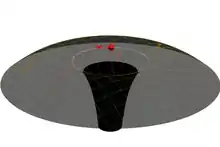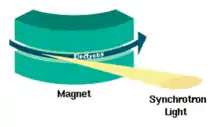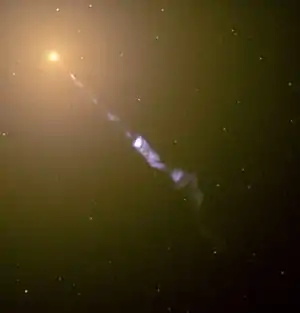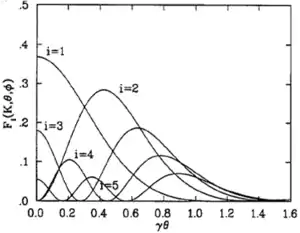Synchrotron radiation
Synchrotron radiation (also known as magnetobremsstrahlung radiation) is the electromagnetic radiation emitted when charged particles are accelerated radially, e.g., when they are subject to an acceleration perpendicular to their velocity (a ⊥ v). It is produced, for example, in synchrotrons using bending magnets, undulators and/or wigglers. If the particle is non-relativistic, the emission is called cyclotron emission. If the particles are relativistic, sometimes referred to as ultrarelativistic, the emission is called synchrotron emission.[1] Synchrotron radiation may be achieved artificially in synchrotrons or storage rings, or naturally by fast electrons moving through magnetic fields. The radiation produced in this way has a characteristic polarization and the frequencies generated can range over the entire electromagnetic spectrum, which is also called continuum radiation.

In astrophysics, synchrotron emission occurs, for instance, due to ultra-relativistic motion of a source around a black hole.[2][3][4][5] When the source performs a circular geodesic around the black hole, the synchrotron radiation occurs for orbits close to the photosphere where the motion is in the ultra-relativistic regime.

.svg.png.webp)
History
Synchrotron radiation was named after it was discovered in Schenectady, New York from a General Electric synchrotron accelerator built in 1946 and announced in May 1947 by Frank Elder, Anatole Gurewitsch, Robert Langmuir and Herb Pollock in a letter entitled "Radiation from Electrons in a Synchrotron".[6] Pollock recounts:
On April 24, Langmuir and I were running the machine and as usual were trying to push the electron gun and its associated pulse transformer to the limit. Some intermittent sparking had occurred and we asked the technician to observe with a mirror around the protective concrete wall. He immediately signaled to turn off the synchrotron as "he saw an arc in the tube." The vacuum was still excellent, so Langmuir and I came to the end of the wall and observed. At first we thought it might be due to Cherenkov radiation, but it soon became clearer that we were seeing Ivanenko and Pomeranchuk radiation.[7]
Properties of synchrotron radiation
- Broad Spectrum (from microwaves to hard X-rays): the users can select the wavelength required for their experiment;
- High Flux: high intensity photon beam allows rapid experiments or use of weakly scattering crystals;
- High Brilliance: highly collimated photon beam generated by a small divergence and small size source (spatial coherence);
- High Stability: submicron source stability;
- Polarization: both linear and circular;
- Pulsed Time Structure: pulsed length down to tens of picoseconds allows the resolution of process on the same time scale.
Emission mechanism
When high-energy particles are in acceleration, including electrons forced to travel in a curved path by a magnetic field, synchrotron radiation is produced. This is similar to a radio antenna, but with the difference that, in theory, the relativistic speed will change the observed frequency due to the Doppler effect by the Lorentz factor, γ. Relativistic length contraction then bumps the frequency observed by another factor of γ, thus multiplying the GHz frequency of the resonant cavity that accelerates the electrons into the X-ray range. The radiated power is given by the relativistic Larmor formula while the force on the emitting electron is given by the Abraham–Lorentz–Dirac force.
The radiation pattern can be distorted from an isotropic dipole pattern into an extremely forward-pointing cone of radiation. Synchrotron radiation is the brightest artificial source of X-rays.
The planar acceleration geometry appears to make the radiation linearly polarized when observed in the orbital plane, and circularly polarized when observed at a small angle to that plane. Amplitude and frequency are however focused to the polar ecliptic.
Synchrotron radiation from accelerators
Synchrotron radiation may occur in accelerators either as a nuisance, causing undesired energy loss in particle physics contexts, or as a deliberately produced radiation source for numerous laboratory applications. Electrons are accelerated to high speeds in several stages to achieve a final energy that is typically in the GeV range. In the Large Hadron Collider, proton bunches produce the radiation at increasing amplitude and frequency as they accelerate with respect to the vacuum field, propagating photoelectrons, which in turn propagate secondary electrons from the pipe walls with increasing frequency and density up to 7×1010. Each proton may lose 6.7 keV per turn due to this phenomenon.[8]
Synchrotron radiation in astronomy

Synchrotron radiation is also generated by astronomical objects, typically where relativistic electrons spiral (and hence change velocity) through magnetic fields. Two of its characteristics include non-thermal power-law spectra, and polarization.[9] It is considered to be one of the most powerful tools in the study of extra-solar magnetic fields wherever relativistic charged particles are present. Most known cosmic radio sources emit synchrotron radiation. It is often used to estimate the strength of large cosmic magnetic fields as well as analyze the contents of the interstellar and intergalactic media.[10]
History of detection
This type of radiation was first detected in a jet emitted by Messier 87 in 1956 by Geoffrey R. Burbidge,[11] who saw it as confirmation of a prediction by Iosif S. Shklovsky in 1953. However, it had been predicted earlier (1950) by Hannes Alfvén and Nicolai Herlofson.[12] Solar flares accelerate particles that emit in this way, as suggested by R. Giovanelli in 1948 and described by J.H. Piddington in 1952.[13]
T. K. Breus noted that questions of priority on the history of astrophysical synchrotron radiation are complicated, writing:
In particular, the Russian physicist V.L. Ginzburg broke his relationships with I.S. Shklovsky and did not speak with him for 18 years. In the West, Thomas Gold and Sir Fred Hoyle were in dispute with H. Alfven and N. Herlofson, while K.O. Kiepenheuer and G. Hutchinson were ignored by them.[14]

Supermassive black holes have been suggested for producing synchrotron radiation, by ejection of jets produced by gravitationally accelerating ions through the super contorted 'tubular' polar areas of magnetic fields. Such jets, the nearest being in Messier 87, have been confirmed by the Hubble telescope as apparently superluminal, travelling at 6 × c (six times the speed of light) from our planetary frame. This phenomenon is caused because the jets are travelling very near the speed of light and at a very small angle towards the observer. Because at every point of their path the high-velocity jets are emitting light, the light they emit does not approach the observer much more quickly than the jet itself. Light emitted over hundreds of years of travel thus arrives at the observer over a much smaller time period (ten or twenty years) giving the illusion of faster than light travel, however there is no violation of special relativity.[15]
Pulsar wind nebulae
A class of astronomical sources where synchrotron emission is important is the pulsar wind nebulae, a.k.a. plerions, of which the Crab nebula and its associated pulsar are archetypal. Pulsed emission gamma-ray radiation from the Crab has recently been observed up to ≥25 GeV,[16] probably due to synchrotron emission by electrons trapped in the strong magnetic field around the pulsar. Polarization in the Crab nebula[17] at energies from 0.1 to 1.0 MeV illustrates a typical synchrotron radiation.
Interstellar and intergalactic media
Much of what is known about the magnetic environment of the interstellar medium and intergalactic medium is derived from observations of synchrotron radiation. Cosmic ray electrons moving through the medium interact with relativistic plasma and emit synchrotron radiation which is detected on Earth. The properties of the radiation allow astronomers to make inferences about the magnetic field strength and orientation in these regions, however accurate calculations of field strength cannot be made without knowing the relativistic electron density.[10]
Formulation
Liénard–Wiechert Field
We start with the expressions for the Liénard–Wiechert field of a point charge of mass and charge :
-
(1)
-
(2)
where R(t′) = r − r0(t′), R(t′) = |R(t′)|, and n(t′) = R(t′)/R(t′), which is the unit vector between the observation point and the position of the charge at the retarded time, and t′ is the retarded time.
In equation (1), and (2), the first terms for B and E resulting from the particle fall off as the inverse square of the distance from the particle, and this first term is called the generalized Coulomb field or velocity field. These terms represents the particle static field effect, which is a function of the component of its motion that has zero or constant velocity, as seen by a distant observer at r. By contrast, the second terms fall off as the inverse first power of the distance from the source, and these second terms are called the acceleration field or radiation field because they represent components of field due to the charge's acceleration (changing velocity), and they represent E and B which are emitted as electromagnetic radiation from the particle to an observer at r.
If we ignore the velocity field in order to find the power of emitted EM radiation only, the radial component of Poynting's vector resulting from the Liénard–Wiechert fields can be calculated to be
-
(3)
Note that
- The spatial relationship between β→ and determines the detailed angular power distribution.
- The relativistic effect of transforming from the rest frame of the particle to the observer's frame manifests itself by the presence of the factors (1 − β→⋅n̂) in the denominator of Eq. (3).
- For ultrarelativistic particles the latter effect dominates the whole angular distribution.
The energy radiated per solid angle during a finite period of acceleration from t′ = T1 to t′ = T2 is
-
(4)
Integrating Eq. (4) over the all solid angles, we get the relativistic generalization of Larmor's formula
- |
However, this also can be derived by relativistic transformation of the 4-acceleration in Larmor's formula.
Velocity perpendicular to acceleration (v ⟂ a): synchrotron radiation

When the charge is in instantaneous circular motion, its acceleration is perpendicular to its velocity β→. Choosing a coordinate system such that instantaneously β→ is in the z direction and is in the x direction, with the polar and azimuth angles θ and φ defining the direction of observation, the general formula Eq. (4) reduces to
In the relativistic limit , the angular distribution can be written approximately as
The factors (1 − βcosθ) in the denominators tip the angular distribution forward into a narrow cone like the beam of a headlight pointing ahead of the particle. A plot of the angular distribution (dP/dΩ vs. γθ) shows a sharp peak around θ = 0.
If we neglect any electric force on the particle, the total power radiated (over all solid angles) from Eq. (4) is
where E is the particle's total (kinetic plus rest) energy, B is the magnetic field, and ρ is the radius of curvature of the track in the field. Note that the radiated power is proportional to 1/m4, 1/ρ2, and B2. In some cases the surfaces of vacuum chambers hit by synchrotron radiation have to be cooled because of the high power of the radiation.
Using
where α is the angle between the velocity and the magnetic field and r is the radius of the circular acceleration, the power emitted is:
Thus the power emitted scales as energy to the fourth, and decreases with the square of the radius and the fourth power of particle mass. This radiation is what limits the energy of an electron-positron circular collider. Generally, proton-proton colliders are instead limited by the maximum magnetic field; this is why, for example, the LHC has a center-of-mass energy 70 times higher than the LEP even though the proton mass is some 2000 times greater than the electron mass.
Radiation integral
The energy received by an observer (per unit solid angle at the source) is
Using the Fourier transformation we move to the frequency space
Angular and frequency distribution of the energy received by an observer (consider only the radiation field)
Therefore, if we know the particle's motion, cross products term, and phase factor, we could calculate the radiation integral. However, calculations are generally quite lengthy (even for simple cases as for the radiation emitted by an electron in a bending magnet, which require the Airy function or the modified Bessel functions).
Integrating

Trajectory of the arc of circumference is
In the limit of small angles we compute
Substituting into the radiation integral and introducing
-
(5)
where the function K is a modified Bessel function of the second kind.
Frequency distribution of radiated energy

From Eq. (5), we observe that the radiation intensity is negligible for . Critical frequency is defined as the frequency when ξ = 1/2 and θ = 0. So,
and critical angle is defined as the angle for which and is approximately
For frequencies much larger than the critical frequency and angles much larger than the critical angle, the synchrotron radiation emission is negligible.
Integrating on all angles, we get the frequency distribution of the energy radiated.

If we define
where y = ω/ωc. Then
Note that , if , and , if
The formula for spectral distribution of synchrotron radiation, given above, can be expressed in terms of a rapidly converging integral with no special functions involved[19] (see also modified Bessel functions) by means of the relation:
Synchrotron radiation emission as a function of the beam energy

First, define the critical photon energy as
Then, the relationship between radiated power and photon energy is shown in the graph on the right side. The higher the critical energy, the more photons with high energies are generated. Note that, there is no dependence on the energy at longer wavelengths.
Polarization of synchrotron radiation
In Eq. (5), the first term is the radiation power with polarization in the orbit plane, and the second term is the polarization orthogonal to the orbit plane.
In the orbit plane , the polarization is purely horizontal. Integrating on all frequencies, we get the angular distribution of the energy radiated
Integrating on all the angles, we find that seven times as much energy is radiated with parallel polarization as with perpendicular polarization. The radiation from a relativistically moving charge is very strongly, but not completely, polarized in the plane of motion.
Solution of equation of motion and undulator equation
An undulator consists of a periodic array of magnets, so that they provide a sinusoidal magnetic field.

Solution of equation of motion:
where
and
and the parameter is called the undulator parameter.

Condition for the constructive interference of radiation emitted at different poles is
Expanding and neglecting the terms in the resulting equation, one obtains
For , one finally gets
This equation is called the undulator equation.
Radiation from the undulator
Radiation integral is
Using the periodicity of the trajectory, we can split the radiation integral into a sum over terms, where is the total number of bending magnets of the undulator.

where
and , , and


The radiation integral in an undulator can be written as
where is the frequency difference to the n-th harmonic. The sum of δ generates a series of sharp peaks in the frequency spectrum harmonics of fundamental wavelength
and Fn depends on the angles of observations and K
On the axis (θ = 0, φ = 0), the radiation integral becomes
and
where
Note that only odd harmonics are radiated on-axis, and as K increases higher harmonic becomes stronger.
See also
Notes
- Yale Astronomy
- Brito, João P. B.; Bernar, Rafael P.; Crispino, Luís C. B. (11 June 2020). "Synchrotron geodesic radiation in Schwarzschild–de Sitter spacetime". Physical Review D. 101 (12): 124019. arXiv:2006.08887. doi:10.1103/PhysRevD.101.124019. ISSN 2470-0010. S2CID 219708236.
- Misner, C. W. (10 April 1972). "Interpretation of Gravitational-Wave Observations". Physical Review Letters. 28 (15): 994–997. doi:10.1103/PhysRevLett.28.994.
- Misner, C. W.; Breuer, R. A.; Brill, D. R.; Chrzanowski, P. L.; Hughes, H. G.; Pereira, C. M. (10 April 1972). "Gravitational Synchrotron Radiation in the Schwarzschild Geometry". Physical Review Letters. 28 (15): 998–1001. doi:10.1103/PhysRevLett.28.998.
- Crispino, L C B; Higuchi, A; Matsas, G E A (29 September 2016). "Corrigendum: Scalar radiation emitted from a source rotating around a black hole (2000 Class. Quantum Grav. 17 19)". Classical and Quantum Gravity. 33 (20): 209502. doi:10.1088/0264-9381/33/20/209502. ISSN 0264-9381.
- Elder, F. R.; Gurewitsch, A. M.; Langmuir, R. V.; Pollock, H. C. (1 June 1947). "Radiation from Electrons in a Synchrotron". Physical Review. American Physical Society (APS). 71 (11): 829–830. doi:10.1103/physrev.71.829.5. ISSN 0031-899X.
- Iwanenko, D.; Pomeranchuk, I. (1 June 1944). "On the Maximal Energy Attainable in a Betatron". Physical Review. APS. 65 (11–12): 343. doi:10.1103/physrev.65.343. ISSN 0031-899X.
- Synchrotron Radiation Damping in the LHC 2005 Joachim Tuckmantel
- Vladimir A. Bordovitsyn, "Synchrotron Radiation in Astrophysics" (1999) Synchrotron Radiation Theory and Its Development, ISBN 981-02-3156-3
- Klein, Ulrich (2014). Galactic and intergalactic magnetic fields. Cham, Switzerland & New York: Springer. ISBN 978-3-319-08942-3. OCLC 894893367.
- Burbidge, G. R. (1956). "On Synchrotron Radiation from Messier 87". The Astrophysical Journal. IOP Publishing. 124: 416. Bibcode:1956ApJ...124..416B. doi:10.1086/146237. ISSN 0004-637X.
- Alfvén, H.; Herlofson, N. (1 June 1950). "Cosmic Radiation and Radio Stars". Physical Review. APS. 78 (5): 616. Bibcode:1950PhRv...78..616A. doi:10.1103/physrev.78.616. ISSN 0031-899X.
- Piddington, J. H. (1953). "Thermal Theories of the High-Intensity Components of Solar Radio-Frequency Radiation". Proceedings of the Physical Society. Section B. IOP Publishing. 66 (2): 97–104. doi:10.1088/0370-1301/66/2/305. ISSN 0370-1301.
- Breus, T. K., "Istoriya prioritetov sinkhrotronnoj kontseptsii v astronomii %t (Historical problems of the priority questions of the synchrotron concept in astrophysics)" (2001) in Istoriko-Astronomicheskie Issledovaniya, Vyp. 26, pp. 88–97, 262 (2001)
- Chase, Scott I. "Apparent Superluminal Velocity of Galaxies". Retrieved 22 August 2012.
- Aliu, E.; Anderhub, H.; Antonelli, L. A.; Antoranz, P.; Backes, M.; et al. (21 November 2008). "Observation of Pulsed γ-Rays Above 25 GeV from the Crab Pulsar with MAGIC". Science. 322 (5905): 1221–1224. arXiv:0809.2998. doi:10.1126/science.1164718. ISSN 0036-8075. PMID 18927358.
- Dean, A. J.; Clark, D. J.; Stephen, J. B.; McBride, V. A.; Bassani, L.; et al. (29 August 2008). "Polarized Gamma-Ray Emission from the Crab". Science. American Association for the Advancement of Science (AAAS). 321 (5893): 1183–1185. doi:10.1126/science.1149056. ISSN 0036-8075. PMID 18755970. S2CID 206509342.
- Jackson, John David (1999). Classical Electrodynamics (3rd ed.). Chichester: Wiley. p. 680. ISBN 978-0-471-30932-1.
- Khokonov, M. Kh. (2004). "Cascade processes of energy loss by emission of hard phonons". Journal of Experimental and Theoretical Physics. Pleiades Publishing Ltd. 99 (4): 690–707. doi:10.1134/1.1826160. ISSN 1063-7761. S2CID 122599440.
References
- Brau, Charles A. Modern Problems in Classical Electrodynamics. Oxford University Press, 2004. ISBN 0-19-514665-4.
- Jackson, John David. Classical Electrodynamics. John Wiley & Sons, 1999. ISBN 0-471-30932-X
- Ishfaq Ahmad, D.Sc. "Measurements of the Relative Oscillator Strengths using the Synchrotron Radiation" (PDF). Proceedings of the National Syposium on Frontier of Physics, National Centre for Theoretical Physics. Pakistan Physical Society. Retrieved 16 January 2012.
External links
- Cosmic Magnetobremsstrahlung (synchrotron Radiation), by Ginzburg, V. L., Syrovatskii, S. I., ARAA, 1965
- Developments in the Theory of Synchrotron Radiation and its Reabsorption, by Ginzburg, V. L., Syrovatskii, S. I., ARAA, 1969
- Lightsources.org
- BioSync – a structural biologist's resource for high energy data collection facilities
- X-Ray Data Booklet